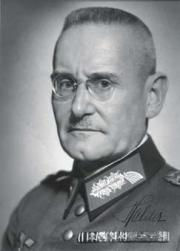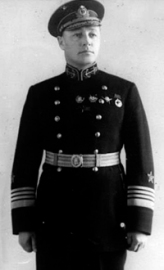[English version at the end]
CUARTELES GENERALES DE BARBARROJA
¡Ya a la venta Barbarroja 03:00 hrs!
OBERKOMMANDO DES HEERES (OKH)
ALTO MANDO DEL EJÉRCITO DE TIERRA
Como parte de la reestructuración de Adolf Hitler de las Fuerzas Armadas alemanas, en 1935 se crea una estructura de mando denominada Oberkommando des Heeres, más conocida por sus siglas OKH. Tendrá la responsabilidad del planeamiento y control de las operaciones de los ejércitos y grupos de ejército (Heeresgruppen). Desde 1938 hasta el 19 de diciembre de 1941 el OKH es dirigido por el mariscal de campo Walther von Brauchitsch (comandante en jefe del Ejército de Tierra<>Heer).

En 1938 además se crea un nuevo escalón de mando superior que en teoría englobaría al OKH, es el Oberkommando der Wehrmacht u OKW. No obstante todas las órdenes del OKW al OKH necesitarán de la aprobación de Adolf Hitler, por lo que esta subordinación es condicionada y no directa. En la práctica será el OKH quien planee y controle la campaña del frente del Este [ver Planeamiento de Barbarroja]. El OKH de 1939 se subdivide en las siguientes ramas:
- Estado Mayor (Halder)
- Personal (B. Keitel)
- Ejército de Reserva (Fromm)
Es interesante notar diferentes secciones dependientes del Estado Mayor, como la Transportes (Gercke) y la del Oberquartiermeister IV (Tippelskirch) de quien depende la oficina de inteligencia de Ejércitos Extranjeros Este (Kinzel) [ver ilustración abajo]. Ambas jugarán un papel decisivo en la preparación de Barbarroja.
Para el establecimiento físico del tal organismo, en 1939 entra en funcionamiento un complejo de instalaciones acorazadas denominado «Maybach I». Consiste en 12 búnkeres semienterrados y disimulados en su súperestructura para dar la apariencia de inocentes casas de campo. Será el hogar del OKH en Wünsdorf-Zossen (45 km. al sur de Berlín). Tal estructura de mando actuará de manera independiente conduciendo las operaciones del «frente ruso» hasta abril de 1945 cuando el mismo Adolf Hitler la subordine totalmente al OKW. La Operación Barbarroja será la gran prueba de fuego con la que los hombres del estado mayor de Zossen tendrán que lidiar.
El planeamiento de la Operación Barbarroja, ya comentado con detalle en otro artículo, no sólo es obra del OKH, sino que su jefe de estado mayor, Franz Halder, asigna la responsabilidad a otros subordinados cuyos estudios cambiarán de manos pasando al OKW (Paulus). Los preliminares del general Marcks, Kinzel y el coronel Feyerabend comienzan sin embargo adoleciendo de un efectivo estudio logístico (amén de otros, como un estudio de inteligencia más realista). O mejor dicho, no de un estudio adecuado sino del hecho de aceptar con resignación la escasa capacidad de las Fuerzas Armadas alemanas de llevar a cabo un despliegue logístico de dimensiones nunca vistas en la historia.
El hombre encargado de tal tarea es el jefe de la Sección de Transportes, general Gercke. Este pone sobre el tapete, no obstante, estas carencias arriba expuestas de la Wehrmacht a nivel logístico. Él sabe que principalmente su abastecimiento y transporte de ingentes cantidades de tropas una vez en la URSS dependerá del ferrocarril, como ha sido tradición en el Heer. Pero el ancho de vía soviético es mayor que el alemán, con lo que este se deberá adaptar con el consiguiente empeño en hombres y material, sin mencionar el tiempo que se empleará en mitad de una campaña que se supone relámpago. Por lo tanto Gercke tiene que rendirse ante las evidencias de que el avituallamiento del Ostheer dependa en sus fases iniciales de camiones para un avance de casi 1.000 kilometros.
Es entonces cuando el general Georg Thomas, jefe de la oficina de Armamento y Economía de Guerra del OKW apunta que Alemania sólo puede aportar el 50% de los neumáticos para una flota de camiones que además no es homogénea, sino que emplea multitud de modelos extranjeros capturados en las campañas relámpago de 1939 y 1940. En síntesis, una auténtica pesadilla logística a la hora de la obtención de repuestos y el mantenimiento de dichos vehículos. En el periodo de 1940-41 no menos del 40% de las divisiones de la Wehrmacht están aún equipadas con material francés. Pero el trasporte logístico entra además en conflicto en diferentes jurisdicciones. Así mientras Gercke es responsable del movimiento por ferrocarril y fluvial (civil y militar), sirviendo tanto en el OKH como Chef der Transportwesens como en el OKW como Wehrmachttransportchef, no tiene jurisdicción en los teatros de operaciones. Es allí el general Wagner quien coordina y ejecuta todo el tráfico motorizado y la supervisión de los cargamentos. Además tanto la Kriegsmarine como la Luftwafe están fuera del ámbito de Gercke. No en pocas ocasiones esto será objeto de agrias discusiones en la URSS entre hombres de la Luftwaffe y del Heer clamando por la prioridad de sus transportes.
Hay otro apunte importante y es que Alemania no ha iniciado una producción a gran escala de material militar aún, es decir lo que correspondería a una “guerra total”, y además no dispone de combustible más que para la concentración de tropas en sus áreas de asalto inicial y dos meses de campaña. Esto, no obstante, no frena a Hitler quien presupone que la destrucción del RKKA (Ejército Rojo) en el campo de batalla se llevará a cabo en 6-10 semanas.
Tradicionalmente en el pensamiento del Estado Mayor alemán, las consideraciones logísticas siempre han sido minusvaloradas y las secciones encargadas “el patito feo” del OKH. Hitler se lanzará a una campaña con escasas reservas en un teatro de operaciones descomunal. Su planteamiento se basa en un rápido golpe de guadaña que cerque al grueso del RKKA y provoque un colapso militar y político y debe de hacerse rápido mucho antes de la llegada del “general invierno”. De no ser así se entrará en una fase inconclusa de desgaste de impredecibles resultados…








¿Querrías conocer los detalles de esta y las demas operaciones?
¡Adquiere la obra cronológica Barbarroja 03:00h en edición de coleccionista!
Sigue interesantes referencias también en Twitter @barbarroja0300h
Deja tu comentario abajo y pulsa en «SEGUIR», para recibir los últimos artículos
[English version]
German Command
BARBAROSSA’S HEADQUARTERS
OBERKOMMANDO DES HEERES (OKH)
(SUPREME ARMY HEADQUARTERS)

As part of the reestructuring of the German Armed Forces urged by Adolf Hitler, in 1935, a new command organization is implemented. It is the Oberkommando des Heeres, or simply known as the OKH. It will be responible of the planning and control of the operations of armies and army groups (Heeresgruppen). From 1938 until the 19th of December 1941 is under the command of Field Marshal Walther von Brauchitsch (Commander-in-Chief of the Ground Forces<>Heer).
In 1938, following Hitler’s projects, a higher command echelon is created which theoretically would emcompass the OKH, it is the new Oberkommando der Wehrmacht or OKW. However all orders from the latter to the former will need Hitler’s approval, which means that in practical terms this subordination is on condition and not direct. The OKH will be the command hierarchy that plans and controls the Eastern Front campaign. [see Planeamiento de Barbarroja]. The 1939 OKH is basically divided in the following sections:
- Staff (Halder)
- Personnel (B. Keitel)
- Replacement Army (Fromm)
It is interesting to note different offices in the hierarchy, like those subordinated to the Halder‘s Staff, like Gercke‘s Transport, and that of the Oberquartiermeister IV (Tippelskirch), under which lays Foreign Armies East (Kinzel). Both play a paramount role in the planning process of Barbarossa.
The works for the settlement of such an organization are finished in 1939 following a project called «Maybach I». It comprises 12 half-earthed bunkers with mock-up roofs that give them the appearance of innocent civilian houses when spotted from the air. It will be the OKH‘s home at Wünsdorf-Zossen (45 km. due south of Berlin). This command body will carry out all Estern Front operations until April, 1945, when Hitler assigns the OKW total control of the OKH‘s activities. Operation Barbarossa will be indeed the major challenge the men of the OKH will have to deal with.
The planning process of Operation Barbarossa, already discussed in another set of articles hereby, is not total responsibility of the OKH, as the Chief of Staff, Halder, orders the job to a group of subordinate officers. Once their task is concluded it will end up in the hands of General Paulus (OKW). The preliminaries of generals Marcks, Kinzel and Colonel Feyerabend lack indeed an effective study of logistics (apart from others, like a down to earth Intelligence data of the adversary). Or better said, not an effective study of logistics, but the fact of accepting the limitations of the German Armed Forces in order to carry out the largest military deployment in the history of wars.
The man in charge of such a job is the Chief of Transports, General Gercke. He, not ignoring the issue, will present the aforementioned logistics problems. He is aware that once in the USSR, the huge ammount of supplies and men will have to rely on the German railroad network, as traditionally in the Heer modus operandi. But the Soviet track gauge is broader than the Reich‘s, which demand a prompt adaptation at any costs in men and materiel in the middle of a so-called Blitzkrieg. Therefore Gercke assumes that the initial Eastern German Army (Ostheer) will have to employ lorries for a daredevil advance of almost 1,000 km.
At that stage is when General Georg Thomas, Chief of the OKW Economy and Armaments Office inputs that Germany is only in a position to deliver 50% of the tyres needed for the project, for a rolling fleet that is not precisely homogeneous; far from that it comprises an array of different models of captured lorries in the campaigns of 1939-40. A real nightmare in order to supply spare parts and adequate maintenance for the materiel. Still in the period of 1940-41 not less than 40% of the Wehrmacht‘s divisions are equipped with French vehicles. On top of that the German logistics network conflict within different jurisdictions. This way while Gercke is responsible for all railroad and fluvial movements (civil and military), serving either in the OKH as Chef der Transportwesens, as in the OKW as Wehrmachttransportchef, is not competent in the theatres of operations. It is there General Wagner who coordinates and carries out the flow of all motor transport and the supervision of supplies. Moreover, either the Kriegsmarine and the Luftwaffe are out of Gercke‘s scope. Not in few occassions this will be a source of sour arguments among Luftwaffe and Heer commanders in the USSR claiming for priority.
There’s another consideration. Germany has not even started in 1941 a large scale military industrial production, in other words, what would be associated to a «total war» output. The Reich does not have enough fuel reserves except for the assembly of forces against the USSR and two months of combat. Nevertheless Hitler assumes this risk as his idea is to achieve victory, annihilating the RKKA (Red Army) in a matter of 6-10 weeks, well before «general winter» sets on the Russian steppes.
Traditionally in the thinking process of the German High Command logistical considerations had been «secondary actors», being the emphasis put in the operations sections. In sinthesys Adolf Hitler will lauch a campaign lacking enough reserves in a gigantic scenario. The idea of Barbarossa follows the premises of a quick encirclement of the adversary that triggers a military and indeed a political crisis that finishes off the Communist regime. He is aware that otherwise, the campaing would go into an inconclusive phase of impredictable consequences…







Did you find this article interesting? Leave your comment below and click «SEGUIR» to keep posted on new publications
Follow other articles in Twitter @barbarroja0300h











